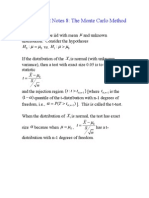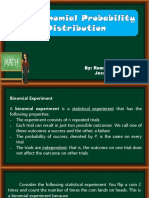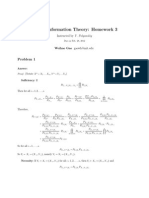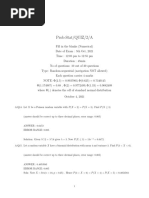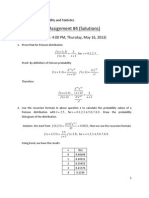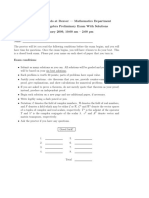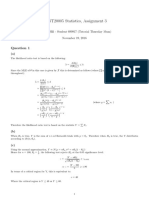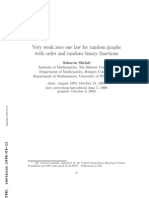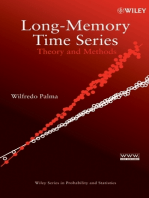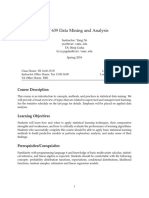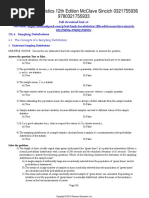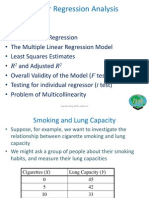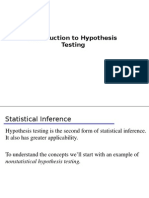TA: Tonja Bowen Bishop
TA: Tonja Bowen Bishop
Uploaded by
Damini ThakurCopyright:
Available Formats
TA: Tonja Bowen Bishop
TA: Tonja Bowen Bishop
Uploaded by
Damini ThakurOriginal Description:
Original Title
Copyright
Available Formats
Share this document
Did you find this document useful?
Is this content inappropriate?
Copyright:
Available Formats
TA: Tonja Bowen Bishop
TA: Tonja Bowen Bishop
Uploaded by
Damini ThakurCopyright:
Available Formats
14.
30 PROBLEM SET 9 SUGGESTED ANSWERS
TA: Tonja Bowen Bishop
Problem 1
For parts (a)-(g), please refer to the relevant sections in the handouts/textbooks.
(h) False. With the knowledge of the distribution of a statistic under
the null hypothesis, we can calculate only , but not :
(i) False. In particular, there are hypothesis tests for which one can
form a GLRT where no optimal test exists, so GLRT could not be optimal
in that case.
(j) Yes. Hypothesis tests are typically constructed by using a test
statistic T . The null hypothesis is rejected if T lies in some interval or if T
lies outside of some interval. The interval is chosen to make the test have
a desired signicance level. This procedure is in essence the same as the
construction of the condence interval.
(k) Recall that and are calculated under dierent distributions
(under the null and under the alternative hypothesis). There is no reason
that it always must be + = 1; although it is possible under some special
circumstances. Also, in general, it is not possible = = 0; again in some
cases we might have = 0 or = 0, but in many cases neither is possible.
NOTE: We might have some cases that = = 0 under very special
and unrealistic situation (can you think of an example of such case ?), and
in that case, the hypothesis test becomes trivial and uninteresting. (why ?)
Problem 2
(a) The probability of committing a Type I error is calculated as
follows:
P (Type I error) = P (reject H0 jH0 is true)
= P (Y
3:20j = 1)
Z 1
=
e y dy
3:20
= 0:04
(b) The probability of committing a Type II error when
calculated as follows:
1
= 4=3 is
14.30 PROBLEM SET 9 SUGGESTED ANSWERS
P (Type II error) = P (dont reject H0 jH1 is true)
4
= P (Y
3:20j = )
3
Z 3:20
3 3y=4
=
e
dy
4
0
Z 2:4
3
=
e u du (change in variable: u = y)
4
0
= 0:91
Problem 3
(a)
i) We rst nd formulas for
and
in terms of k:
= P (Type I error) = P (reject H0 jH0 is true)
Z k
Z k
=
f0 (x)dx =
2xdx
= k
0
2
= P (Type II error) = P (dont reject H0 jHA is true)
Z 1
Z 1
=
fA (x)dx =
(2 2x)dx
k
= k2
2k + 1
Note that we were able to write down expressions for and because
with only 1 observation x; we knew that x had to be our statistic, and
furthermore our test would be of the form reject H0 for x < kbecause we
are more likely to have observed a small x if HA is true.
min( + ) = min(2k 2
k
@(2k 2
So
2k + 1)
= 4k
@k
is minimized at k = 1=2:
ii)
1
4
1
4
2k + 1)
2=0
= 12 :
iii) With k = 1=2, the testing procedure is then to reject the null for
x < k = 1=2: So we do not reject the null for x = 0:6
(b)
Z
f0 (x)dx =
i) Find k such that
Z
2xdx = k 2 = 0:1 [why 0.1, when the restriction is
this implies k =
0:1:
0:10 ?]
14.30 PROBLEM SET 9 SUGGESTED ANSWERS
ii) Then
(2
2x)dx
0:1
x2 ]1p0:1
p
2 0:1
= [2x
= 1:1
iii) For x = 0:4, we do not reject because
p
x = 0:4 > k = 0:1
(c) With ten observations, you could use, for instance
T (X) = X
and reject the if X < k (for appropriate k).
Problem 4
We have two simple hypotheses, so we should be able to derive an optimal test statistic using the Neyman-Pearson lemma. The lemma tells
us that the best test can be achieved by constructing the test statistic
1 ;:::;xn j =1)
T = ff01 (x
(x1 ;:::;xn j =0) and then rejecting the null ( = 0) whenever T > k,
where k is the critical value such that the probability of type I error is equal
to = 0:005. We know that the likelihood function is
n
f (x1 ; :::; xn j ) =
i=1
f (xi j )
1
p e
i=1 2
= (2 )
n
2
)2
(xi
2
1
2
P
(xi
)2
Then we have
T
(2 )
n
2
(2 )
1
2
= e
= enX
e
n
2
1
2
P
(xi 1)2
1 P 2
xi
2
P
( 2xi +1)
n
2
Thus we should reject the null hypothesis if enX 2 > k, or equivalently,
reject the null if X > 2 ln(k)+n
. Thus we have a test of the form "reject if
2n
X > c" for some c (n), and we know how to determine the proper value of c
for our desired condence level. We want Pr X > c j = 0 = = 0:005,
14.30 PROBLEM SET 9 SUGGESTED ANSWERS
so we use
0:005 = Pr X > c j = 0
0
X 0
c 0
= Pr @ q
> q j
1
n
= Pr Z >
1
n
nc
From the Z-table, I nd that we must have
= 0A
nc = 1:65, so c =
the nal form of our test is that we reject the null if X >
Problem 5
(a) H0 :
X
if
= 7 versus H1 :
1:65
p .
n
Thus
1:65
p .
n
= 6.
(b) The
And under the null
p test statistics is sample mean: T = X: p
N (7; 1= 10);and under the alternative X N (7; 1 10): We reject H0
1
1
p
(0:05)
10
1
= 7 p (1:65)
10
= 7 (0:32)(1:65)
= 6:47
X < 7
So we reject H0 because X = 6:2 < 6:47:
(c)
P ower = 1
= 1
=
=
=
=
(d) With unknown
P (dont reject H0 jHA is true)
6:47 6
p
1
1
1= 10
6:47 6
p
1= 10
(1:49)
0:93
2,
the test statistic under the null is
T =
X
p
S= n
t(10
1)
14.30 PROBLEM SET 9 SUGGESTED ANSWERS
we reject H0 if
X
p
S= n
6:2 7
p
p
1:5= 10
<
t9 ( ), where
is a signicance level
,
=
2:5 <
1:83 (from the table)
So we reject H0 :
H1 :
(e) In this case, the test then becomes two-sided [H0 : = 7 versus
6= 7], so all the procedures used before should be modied accordingly.
Problem 6
Suppose Xi
N ( X ; 1); i = 1; :::; nX and Zj
N ( Z ; 1); j = 1; :::; nZ
and all the observations are independent. You want to test the hypothesis
that the means are equal against the alternative that they are not. Use the
statistic
T =p
(X
Z)
1=nX + 1=nZ
(a) The test statistic T can take any real number, and if the absolute
value of T is su cientlydierent from 0; we will reject the null hypothesis
that the means are equal.
(b) Note that T is a linear transformation of (nX + nZ ) normal
random variables - hence, we can guess that T
N (E[T ]; V ar[T ]):The
mean and variance of T are:
"
#
(X Z)
E[T ] = E p
1=nX + 1=nZ
1
= p
E[(X Z)]
1=nX + 1=nZ
1
= p
E[X] E[Z]
1=nX + 1=nZ
1 X
1
1 X
= p
E
Xi
E
Zj
nX
nZ
1=nX + 1=nZ
1
= p
( X
Z)
1=nX + 1=nZ
= 0 (under the null X = Z )
14.30 PROBLEM SET 9 SUGGESTED ANSWERS
"
(X
V ar[T ] = V ar p
Z)
1=nX + 1=nZ
1
V ar[X Z]
1=nX + 1=nZ
1
V ar[X] + V ar[Z] (independence)
1=nX + 1=nZ
1
1 X
1 X
V ar
Zj
Xi + V ar
1=nX + 1=nZ
nX
nZ
1
1
1
nX (1) + 2 nZ (1)
1=nX + 1=nZ
n2X
nZ
!
1
1
1
+
nX +nZ
nX
nZ
n n
=
=
=
=
nX nZ
nX + nZ
nX + nZ
nX nZ
= 1
So T
N (0; 1):
(c) Since the distribution of the test statistic T is the standard normal under the null, we reject the null when jtj > z =2 :
Problem 7
(a) Consider the test statistic T =
and
(nY
SY2 is
1)SY2
dened analogously.
2
Y
2
(nY
1) ,
2 =
where SX
We know that
n
Y
P
i=1
nX 1
2
(nX 1)SX
2
X
2
X
2,
Y
so we can rewrite T as
n
X
P
Xi
i=1
2
(nX 1)
n
X
P
Un-
2
(nX 1)SX
2 (n
1
)
X X
2
(nY 1)SY
2 (n
Y 1)
Y
Xi
1; nY
=
i=1
Yi
= 8:75. So T =
118=5
8:75=3
and
1) : So we reject for T > c, where c is dened by Pr (F (nX
(b) We have nX = 6, nY = 4, X = 12, Y = 2:75,
118, and
and that these two statistics are independent.
der the null hypothesis,
F (nX 1; nY
= 0:10.
2
SX
,
SY2
= 8:09. From the F-table,
our critical value, c, is equal to 5.31, so we reject the null hypothesis.
1) > c) =
You might also like
- Cameron & Trivedi - Solution Manual Cap. 4-5Document12 pagesCameron & Trivedi - Solution Manual Cap. 4-5Luchín Andrés González0% (1)
- Cleartrip Flight Domestic E-TicketDocument3 pagesCleartrip Flight Domestic E-TicketDamini Thakur100% (2)
- Engineering Mechanics-MIT NOTESDocument355 pagesEngineering Mechanics-MIT NOTESDamini ThakurNo ratings yet
- A Review of Basic Statistical Concepts: Answers To Problems and Cases 1Document227 pagesA Review of Basic Statistical Concepts: Answers To Problems and Cases 1Thiên BìnhNo ratings yet
- LSCM 3403 Assigned Problems - F 2018Document2 pagesLSCM 3403 Assigned Problems - F 2018WendyNo ratings yet
- Statistics 512 Notes 8: The Monte Carlo Method: X X H H X Is Normal (With UnknownDocument7 pagesStatistics 512 Notes 8: The Monte Carlo Method: X X H H X Is Normal (With UnknownSandeep SinghNo ratings yet
- Ordinary Differential Equations in A Banach SpaceDocument17 pagesOrdinary Differential Equations in A Banach SpaceChernet TugeNo ratings yet
- Mvue NotesDocument5 pagesMvue NotesAswathy G MenonNo ratings yet
- CH 9 SolDocument6 pagesCH 9 SolFinnigan O'FlahertyNo ratings yet
- F (X) PQ, X 0,1,2, : 1.1.1. Geometric (Pascal) DistributionDocument14 pagesF (X) PQ, X 0,1,2, : 1.1.1. Geometric (Pascal) DistributionKimondo KingNo ratings yet
- Binomial DistributionDocument22 pagesBinomial DistributionRemelyn AsahidNo ratings yet
- Tutorial 7 So LNDocument10 pagesTutorial 7 So LNBobNo ratings yet
- Midterm SolutionsDocument5 pagesMidterm SolutionsLinbailuBellaJiangNo ratings yet
- Random Variables: Exercise 2.1 (Uniform Distribution)Document7 pagesRandom Variables: Exercise 2.1 (Uniform Distribution)pseudomotiveNo ratings yet
- 6.441 - Information Theory: Homework 3: Problem 1Document6 pages6.441 - Information Theory: Homework 3: Problem 1Kushagra SinghalNo ratings yet
- hw1 Sol PDFDocument7 pageshw1 Sol PDFArif WahlaNo ratings yet
- ECE 534: Exam II: Monday November 14, 2011 7:00 P.M. - 8:15 P.M. 103 TalbotDocument2 pagesECE 534: Exam II: Monday November 14, 2011 7:00 P.M. - 8:15 P.M. 103 TalbotThinhNo ratings yet
- Tests Based On Asymptotic PropertiesDocument6 pagesTests Based On Asymptotic PropertiesJung Yoon SongNo ratings yet
- CH 3 SolutionsDocument10 pagesCH 3 SolutionsAndy LeeNo ratings yet
- CH 04Document6 pagesCH 04JokoSusiloNo ratings yet
- MAT2337 December 2010 Final ExamDocument11 pagesMAT2337 December 2010 Final ExamDavid LinNo ratings yet
- Introduction To Nonlinear FilteringDocument126 pagesIntroduction To Nonlinear FilteringAraceli GomezNo ratings yet
- An Antibiotic Resistance TestDocument20 pagesAn Antibiotic Resistance TestPresha PatelNo ratings yet
- Solution 1Document3 pagesSolution 1Justin LiaoNo ratings yet
- Probability Distribution - Binomial DistributionDocument16 pagesProbability Distribution - Binomial Distributionlangelihle822451No ratings yet
- MC0074 - Statistical and Numerical Methods Using C++Document14 pagesMC0074 - Statistical and Numerical Methods Using C++Ravish RavindranNo ratings yet
- Stat330: Homework #5: Mr. Lanker Section ADocument13 pagesStat330: Homework #5: Mr. Lanker Section AFrangel Hernández MartinezNo ratings yet
- Test 2 ADocument7 pagesTest 2 ASandeepNo ratings yet
- Test Math Final SolutionsDocument6 pagesTest Math Final SolutionsslimehatNo ratings yet
- CS 229 Spring 2016 Problem Set #3: Theory & Unsupervised LearningDocument5 pagesCS 229 Spring 2016 Problem Set #3: Theory & Unsupervised LearningAchuthan SekarNo ratings yet
- Assignment 4 SolutionsDocument9 pagesAssignment 4 SolutionsAmy ParkerNo ratings yet
- Statistics 100A Homework 6 Solutions: Ryan RosarioDocument13 pagesStatistics 100A Homework 6 Solutions: Ryan RosarioDeepak PandeyNo ratings yet
- P P (Red Ball) 3/5, Which Remains Constant From Trial To TrialDocument10 pagesP P (Red Ball) 3/5, Which Remains Constant From Trial To Trialrohitrgt4uNo ratings yet
- Linalg 09 Jan SolnsDocument6 pagesLinalg 09 Jan SolnsDr Thushar Rai NNo ratings yet
- ECE567 16F Hw1soln PDFDocument5 pagesECE567 16F Hw1soln PDFSähilDhånkhårNo ratings yet
- Statistics Probability Midterm Cheat SheetDocument5 pagesStatistics Probability Midterm Cheat SheetJeff Farmer0% (1)
- MAST20005 Statistics Assignment 3Document8 pagesMAST20005 Statistics Assignment 3Anonymous na314kKjOANo ratings yet
- Ex HypothesistestDocument22 pagesEx HypothesistestYana CovarNo ratings yet
- Properties of The Trinomial DistributionDocument2 pagesProperties of The Trinomial DistributionPerry01No ratings yet
- Section A: Multiple Choice (24 Points) : (2 Points Each, - 1 Per Incorrect Circle/non-Circle, Minimum 0 Points Per Problem)Document11 pagesSection A: Multiple Choice (24 Points) : (2 Points Each, - 1 Per Incorrect Circle/non-Circle, Minimum 0 Points Per Problem)Rohit SuryavanshiNo ratings yet
- MC0074 - Set 2Document4 pagesMC0074 - Set 2nikeneelNo ratings yet
- 131A 1 Prac Final SolDocument7 pages131A 1 Prac Final SolDylan LerNo ratings yet
- 20131-Ec Diferenciales Carlos - jarrIAGAM.tarea1Document3 pages20131-Ec Diferenciales Carlos - jarrIAGAM.tarea1Janai ArriagaNo ratings yet
- Applied Statistics: Normal DistributionDocument11 pagesApplied Statistics: Normal Distributioniiyousefgame YTNo ratings yet
- CS340 Machine Learning Information TheoryDocument22 pagesCS340 Machine Learning Information Theorypam6722No ratings yet
- 36-225 - Introduction To Probability Theory - Fall 2014: Solutions For Homework 1Document6 pages36-225 - Introduction To Probability Theory - Fall 2014: Solutions For Homework 1Nick LeeNo ratings yet
- محتوى مقرر Probability and Statistics 5Document196 pagesمحتوى مقرر Probability and Statistics 5zayedalnaggarNo ratings yet
- Binomial Distribution 23 SepDocument2 pagesBinomial Distribution 23 Sepपशुपति नाथNo ratings yet
- Saharon Shelah - Very Weak Zero One Law For Random Graphs With Order and Random Binary FunctionsDocument11 pagesSaharon Shelah - Very Weak Zero One Law For Random Graphs With Order and Random Binary FunctionsJgfm2No ratings yet
- 302 FinalDocument7 pages302 Finalrockyupendar000No ratings yet
- IIT Jam Maths and Statistics Question Paper 2011Document35 pagesIIT Jam Maths and Statistics Question Paper 2011Haresh ChaudhariNo ratings yet
- Headsoln Master MethodDocument6 pagesHeadsoln Master MethodSumit DeyNo ratings yet
- Statistics 221 Summary of MaterialDocument5 pagesStatistics 221 Summary of MaterialJames McQueenNo ratings yet
- Optimal Control (Course Code: 191561620)Document4 pagesOptimal Control (Course Code: 191561620)Abdesselem BoulkrouneNo ratings yet
- Random Signals: 1 Kolmogorov's Axiomatic Definition of ProbabilityDocument14 pagesRandom Signals: 1 Kolmogorov's Axiomatic Definition of ProbabilitySeham RaheelNo ratings yet
- SCH MFF Wi21 PRDocument9 pagesSCH MFF Wi21 PRhansNo ratings yet
- Binomial and Multinomial DistributionDocument5 pagesBinomial and Multinomial Distribution225037No ratings yet
- Osobine VarDocument19 pagesOsobine Varenes_osmić_1No ratings yet
- Hypothesis Testing (Hotelling's T - Statistic) : 4.1 The Union-Intersection PrincipleDocument19 pagesHypothesis Testing (Hotelling's T - Statistic) : 4.1 The Union-Intersection PrincipleGeorge WangNo ratings yet
- Unbiased StatisticDocument15 pagesUnbiased StatisticOrYuenyuenNo ratings yet
- De Moiver's Theorem (Trigonometry) Mathematics Question BankFrom EverandDe Moiver's Theorem (Trigonometry) Mathematics Question BankNo ratings yet
- Analysis of Educational Status of Scheduled Castes and Scheduled Tribes in India (2011)Document1 pageAnalysis of Educational Status of Scheduled Castes and Scheduled Tribes in India (2011)Damini ThakurNo ratings yet
- Tests For A Population Mean The Critical Region and The P-ValueDocument8 pagesTests For A Population Mean The Critical Region and The P-ValueDamini ThakurNo ratings yet
- 2 Basics of Probability and StatisticsDocument4 pages2 Basics of Probability and StatisticsDamini ThakurNo ratings yet
- Lecture 31: Lagrange Multiplier Method: P DF DT T DR DT P P P PDocument2 pagesLecture 31: Lagrange Multiplier Method: P DF DT T DR DT P P P PSaurabh TomarNo ratings yet
- India and WTO: Table of ContentsDocument11 pagesIndia and WTO: Table of ContentsDamini ThakurNo ratings yet
- Nikhil CVDocument2 pagesNikhil CVDamini ThakurNo ratings yet
- A Monte Carlo Study of Growth Regressions: William R. Hauk JRDocument45 pagesA Monte Carlo Study of Growth Regressions: William R. Hauk JRDamini ThakurNo ratings yet
- Nikhil CVDocument1 pageNikhil CVDamini ThakurNo ratings yet
- Exponential Demand FunctionsDocument19 pagesExponential Demand FunctionsDamini ThakurNo ratings yet
- CE 481 Solid Waste & Environmental PollutionDocument140 pagesCE 481 Solid Waste & Environmental PollutionDamini ThakurNo ratings yet
- Final Tut-6Document2 pagesFinal Tut-6nikhilgyl93No ratings yet
- CH-8 Hypothesis TestingDocument37 pagesCH-8 Hypothesis TestingeeffefefNo ratings yet
- GrubbsDocument2 pagesGrubbsAldrin HernandezNo ratings yet
- Principles of Multivariate AnalysisDocument6 pagesPrinciples of Multivariate AnalysisSergio Serrano AyvarNo ratings yet
- Chap05 ForecastingDocument61 pagesChap05 Forecastingtaylor swiftyyyNo ratings yet
- RSH Qam11 ch05Document84 pagesRSH Qam11 ch05semen.12qazNo ratings yet
- ISO 2854-1976 (E) : Statistical Data CalculationsDocument12 pagesISO 2854-1976 (E) : Statistical Data CalculationsLaffineur EricNo ratings yet
- STAT 639 Data Mining and Analysis: Course DescriptionDocument5 pagesSTAT 639 Data Mining and Analysis: Course DescriptionjackzhangNo ratings yet
- AFRAID: Fraud Detection Via Active Inference in Time-Evolving Social NetworksDocument8 pagesAFRAID: Fraud Detection Via Active Inference in Time-Evolving Social NetworksratulsurNo ratings yet
- Index Number Unit-4 FinalDocument57 pagesIndex Number Unit-4 FinalSachin KirolaNo ratings yet
- Statistics 12th Edition McClave Test Bank 1Document16 pagesStatistics 12th Edition McClave Test Bank 1kenneth100% (62)
- Research Paper On Gender InequalityDocument45 pagesResearch Paper On Gender InequalityDhritiNo ratings yet
- AQ077-3-2 Probability and Statistical Modelling SOW VE1Document5 pagesAQ077-3-2 Probability and Statistical Modelling SOW VE1Kanagi RajandranNo ratings yet
- OLS Estimation of Single Equation Models PDFDocument40 pagesOLS Estimation of Single Equation Models PDFzoyaNo ratings yet
- Business Analytics: Advance: Simple & Multiple Linear RegressionDocument38 pagesBusiness Analytics: Advance: Simple & Multiple Linear RegressionKetan BhaleraoNo ratings yet
- DMUU Assignment2 - GroupCDocument4 pagesDMUU Assignment2 - GroupCJoyal ThomasNo ratings yet
- Linear Regression Analysis: Gaurav Garg (IIM Lucknow)Document96 pagesLinear Regression Analysis: Gaurav Garg (IIM Lucknow)Sakshi JainNo ratings yet
- Pertumbuhan Bakteri (Optical Density) : Regression StatisticsDocument3 pagesPertumbuhan Bakteri (Optical Density) : Regression StatisticsHikmahmutNo ratings yet
- Time Series Analysis - Data Exploration and Visualization. - by Himani Gulati - Jovian - MediumDocument3 pagesTime Series Analysis - Data Exploration and Visualization. - by Himani Gulati - Jovian - MediumvaskoreNo ratings yet
- GBU 3311 Quantitative Methods in Business Fall 2022 Homework 1Document2 pagesGBU 3311 Quantitative Methods in Business Fall 2022 Homework 1Oumaima LasfarNo ratings yet
- Lecture 1 - Simple Linear RegressionDocument9 pagesLecture 1 - Simple Linear RegressionAnonymous f6MGixKKhNo ratings yet
- Wilcoxon Test: Posts: 6 Joined: Tue Jul 21, 2009 7:00 AmDocument3 pagesWilcoxon Test: Posts: 6 Joined: Tue Jul 21, 2009 7:00 AmdawnheraldNo ratings yet
- Intro To Hypothesis TestingDocument83 pagesIntro To Hypothesis TestingrahulrockonNo ratings yet
- Foundations of Statistical InferenceDocument22 pagesFoundations of Statistical InferenceVida Suelo QuitoNo ratings yet
- Forecasting in Industrial EngineeringDocument61 pagesForecasting in Industrial EngineeringSuneel Kumar Meena100% (9)
- Math 2 - Regular Segment 2Document23 pagesMath 2 - Regular Segment 2ACuomo-Yokel1No ratings yet
- Statistik Cinda IiDocument4 pagesStatistik Cinda IiUnita SariNo ratings yet
- Advanced R Programming For Data Analytics in Business - Unit 6 - Week-3Document4 pagesAdvanced R Programming For Data Analytics in Business - Unit 6 - Week-3Rama BhushanNo ratings yet






